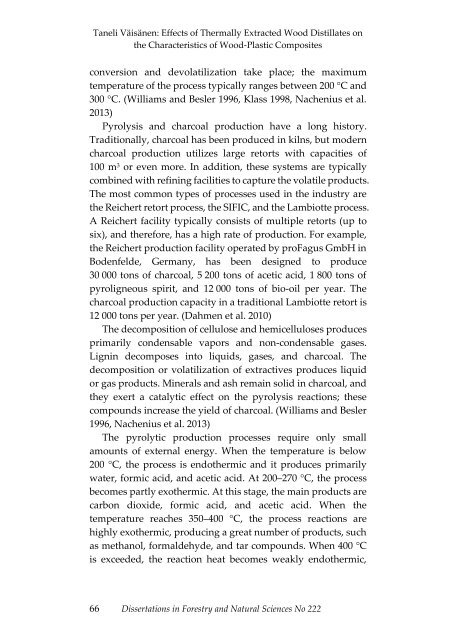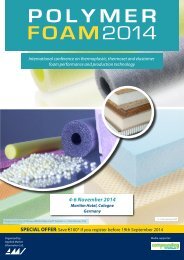Dissertations in Forestry and Natural Sciences
24lYKFN
24lYKFN
You also want an ePaper? Increase the reach of your titles
YUMPU automatically turns print PDFs into web optimized ePapers that Google loves.
Taneli Väisänen: Effects of Thermally Extracted Wood Distillates on<br />
the Characteristics of Wood-Plastic Composites<br />
conversion <strong>and</strong> devolatilization take place; the maximum<br />
temperature of the process typically ranges between 200 °C <strong>and</strong><br />
300 °C. (Williams <strong>and</strong> Besler 1996, Klass 1998, Nachenius et al.<br />
2013)<br />
Pyrolysis <strong>and</strong> charcoal production have a long history.<br />
Traditionally, charcoal has been produced <strong>in</strong> kilns, but modern<br />
charcoal production utilizes large retorts with capacities of<br />
100 m 3 or even more. In addition, these systems are typically<br />
comb<strong>in</strong>ed with ref<strong>in</strong><strong>in</strong>g facilities to capture the volatile products.<br />
The most common types of processes used <strong>in</strong> the <strong>in</strong>dustry are<br />
the Reichert retort process, the SIFIC, <strong>and</strong> the Lambiotte process.<br />
A Reichert facility typically consists of multiple retorts (up to<br />
six), <strong>and</strong> therefore, has a high rate of production. For example,<br />
the Reichert production facility operated by proFagus GmbH <strong>in</strong><br />
Bodenfelde, Germany, has been designed to produce<br />
30 000 tons of charcoal, 5 200 tons of acetic acid, 1 800 tons of<br />
pyroligneous spirit, <strong>and</strong> 12 000 tons of bio-oil per year. The<br />
charcoal production capacity <strong>in</strong> a traditional Lambiotte retort is<br />
12 000 tons per year. (Dahmen et al. 2010)<br />
The decomposition of cellulose <strong>and</strong> hemicelluloses produces<br />
primarily condensable vapors <strong>and</strong> non-condensable gases.<br />
Lign<strong>in</strong> decomposes <strong>in</strong>to liquids, gases, <strong>and</strong> charcoal. The<br />
decomposition or volatilization of extractives produces liquid<br />
or gas products. M<strong>in</strong>erals <strong>and</strong> ash rema<strong>in</strong> solid <strong>in</strong> charcoal, <strong>and</strong><br />
they exert a catalytic effect on the pyrolysis reactions; these<br />
compounds <strong>in</strong>crease the yield of charcoal. (Williams <strong>and</strong> Besler<br />
1996, Nachenius et al. 2013)<br />
The pyrolytic production processes require only small<br />
amounts of external energy. When the temperature is below<br />
200 °C, the process is endothermic <strong>and</strong> it produces primarily<br />
water, formic acid, <strong>and</strong> acetic acid. At 200–270 °C, the process<br />
becomes partly exothermic. At this stage, the ma<strong>in</strong> products are<br />
carbon dioxide, formic acid, <strong>and</strong> acetic acid. When the<br />
temperature reaches 350–400 °C, the process reactions are<br />
highly exothermic, produc<strong>in</strong>g a great number of products, such<br />
as methanol, formaldehyde, <strong>and</strong> tar compounds. When 400 °C<br />
is exceeded, the reaction heat becomes weakly endothermic,<br />
66 <strong>Dissertations</strong> <strong>in</strong> <strong>Forestry</strong> <strong>and</strong> <strong>Natural</strong> <strong>Sciences</strong> No 222



